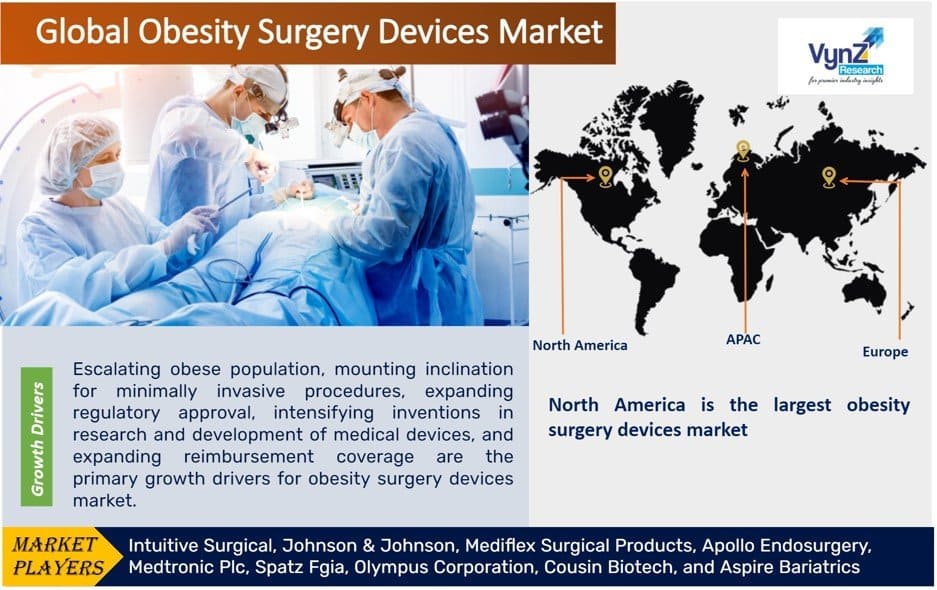| Status : Upcoming | Report Code : VRHC1161 | Industry : Healthcare | Available Format :

|

Global Obesity Surgery Devices Market – Analysis and Forecast (2025-2030)
Industry Insights by Type (Minimally Invasive Surgical Devices (Stapling Devices, Suturing Devices, Energy/Vessel-Sealing Devices, and Accessories), and Non-Invasive Surgical Devices), by Procedure (Sleeve Gastrectomy, Non-Invasive Bariatric Surgery, Gastric Bypass, Mini-Gastric Bypass, Revision Bariatric Surgery, Adjustable Gastric Banding, and Biliopancreatic Diversion With Duodenal Switch), and by Geography (U.S., Canada, Germany, U.K., France, Spain, Japan, China, India, and Middle East & Africa)
Industry Overview
The Global Obesity Surgery Devices Market is growing at a significant rate, due to escalating obese population, mounting inclination for minimally invasive procedures. Different types such as minimally invasive surgical devices and non-invasive surgical devices contributed to the obesity surgery devices market size. The market has witnessed a high demand for minimally invasive surgical devices due to the mounting occurrence of obesity and the necessity for minimal discomfort and trauma.

Obesity surgery is also known as bariatric surgery. It is a surgical weight loss solution which restricts the ability of the stomach or the absorption of calories. Need for less invasive methods for obesity surgery, and the mounting need for gastric electrical stimulation are the major trends observed in the obesity surgery devices market.
Market Segmentation
Insight by Type
On the basis of the type, the market is subdivided into minimally invasive surgical devices, and non-invasive surgical devices. Of all types, minimally invasive surgical devices segment accounted for a larger share in the market due to the mounting occurrence of obesity, necessity for minimal discomfort and trauma, and demand for less scar and incisions. Moreover, the non-invasive surgical devices are expected to grow at a faster rate in the market, due to fewer complications.
The minimally invasive surgical devices are further subdivided into stapling devices, suturing devices, energy/vessel-sealing devices, and accessories.
Insight by Procedure
On the basis of the procedure, the market is subdivided into sleeve gastrectomy, non-invasive bariatric surgery, gastric bypass, mini-gastric bypass, revision bariatric surgery, adjustable gastric banding, and biliopancreatic diversion with duodenal switch. Of all the procedures, the sleeve gastrectomy accounted foremost share and is expected to grow at the fastest rate in the obesity surgery devices market due to fewer complications, effectiveness, safety, and affordability.
Global Obesity Surgery Devices Market Report Coverage
|
Report Metric |
Details |
|
Historical Period |
2018 - 2023 |
|
Base Year Considered |
2024 |
|
Forecast Period |
2025 - 2030 |
|
Market Size in 2024 |
U.S.D. xx.x Billion |
|
Revenue Forecast in 2030 |
U.S.D. xx.x Billion |
|
Growth Rate |
x.x% |
|
Segments Covered in the Report |
By Type and By Procedure |
|
Report Scope |
Market Trends, Drivers, and Restraints; Revenue Estimation and Forecast; Segmentation Analysis; Impact of COVID-19; Companies’ Strategic Developments; Market Share Analysis of Key Players; Company Profiling |
|
Regions Covered in the Report |
North America, Europe, Asia-Pacific, Middle East, South America and Rest of the World |
Industry Dynamics
Industry Trends
Need for less invasive methods for obesity surgery, and the mounting need for gastric electrical stimulation are the major trends observed in the obesity surgery devices market.
Gastric electrical stimulation involves the use of an electrical device called a gastric pacemaker. The device activates mild electrical stimulations in the stomach nerves. It is used to surge the feeling of satiety after eating in order to decrease food intake, thus leading to weight loss.
Growth Drivers
Escalating obese population, mounting inclination for minimally invasive procedures, expanding regulatory approval, intensifying inventions in research and development of medical devices, and expanding reimbursement coverage are the primary growth drivers for obesity surgery devices market. For instance, according to the World Health Organization (WHO), more than 1.9 million adults were overweight and 650 million adults were obese. In addition, in 2016, 13% of the adult’s population was obese. Moreover, according to the WHO in 2016, 41 million children under the age of five years were obese and overweight.
Changing lifestyle and excessive intake of calories, expanding the number of bariatric surgeries, escalating expenditure on weight loss procedure, growing alertness among the obese population, and government initiatives for escalating alertness about unhealthy food and drinks are also facilitating the growth for the obesity surgery devices market. For instance, according to the American Society for Metabolic and Bariatric Surgery approximately 158,000 bariatric surgeries were conducted and the number increased to 228,000 surgeries in 2017.
Challenges
Product recalls, the elevated price associated with surgeries, lack of appropriate healthcare infrastructure, limited insurance coverage and post-operative complications of bariatric surgery are some of the factors hindering the growth of the market.
The lack of awareness regarding diseases related to obesity, the selective nature of obesity surgery, and costly surgical procedure are the major challenges for the growth of obesity surgery devices market.
Opportunities
Emerging markets such as China and India and mounting medical tourism would create opportunities for the obesity surgery devices market.
Medical tourism is gaining traction with people touring abroad to seek improved quality and cost-effective medical, dental and surgical care. Presently, the expense is considered to be a significant factor when it comes to obesity surgery. Medical tourism for obesity surgery is mounting speedily with thousands of persons touring out of the U.S., South Africa, Canada, and Europe to undergo surgeries for this condition.
Geographic Overview
Geographically, North America is the largest obesity surgery devices market as in the region the number of bariatric surgeries is escalating, and mounting government proposals and funding for research and development. In addition, escalating obese population, changing lifestyle and excessive intake of calories, and mounting inclination for minimally invasive procedures are also up surging growth of the North American obesity surgery devices market. For instance, according to the Centers for Disease Control and Prevention, approximately 93.3 million of the U.S. adults were obese in 2015-2016.
Asia-Pacific is observed to witness the fastest growth in the market, due to the escalating number of bariatric surgeries. In addition, escalating medical tourism, the mounting occurrence of the obese population, changing lifestyle, and government initiatives to limit obesity are also creating a positive impact on the obesity surgery devices market growth in the region.
Competitive Insight
The obesity surgery devices industry players are catering to the demand of these devices by investing in technologically advanced products in their product portfolio across the globe. In June 2018, Apollo Endosurgery, Inc. received FDA approval of revised labeling for the ORBERA intragastric balloon system. Intuitive Surgical, Johnson & Johnson, Mediflex Surgical Products, Apollo Endosurgery, Medtronic Plc, Spatz Fgia, Olympus Corporation, Cousin Biotech, and Aspire Bariatrics are the key players offering obesity surgery devices.
The Obesity Surgery Devices Market report offers a comprehensive market segmentation analysis along with an estimation for the forecast period 2025–2030.
Segments Covered in the Report
- By Type
- Minimally invasive surgical devices
- Non-invasive surgical devices
- By Procedure
- Sleeve gastrectomy
- Non-invasive bariatric surgery
- Gastric bypass
- Mini-gastric bypass
- Revision bariatric surgery
- Adjustable gastric banding
- Biliopancreatic diversion with duodenal switch
Region Covered in the Report
- North America
- U.S.
- Canada
- Mexico
- Europe
- Germany
- U.K.
- France
- Italy
- Spain
- Russia
- Rest of Europe
- Asia-Pacific (APAC)
- China
- Japan
- India
- South Korea
- Rest of Asia-Pacific
- Rest of the World (RoW)
- Brazil
- Saudi Arabia
- South Africa
- U.A.E.
- Other Countries
.png)
Source: VynZ Research
.png)
Source: VynZ Research
Frequently Asked Questions
Purchase Options
Latest Report
Research Methodology
- Desk Research / Pilot Interviews
- Build Market Size Model
- Research and Analysis
- Final Deliverabvle
Connect With Our Sales Team
- Toll-Free: 1 888 253 3960
- Phone: +91 9960 288 381
- Email: enquiry@vynzresearch.com
Obesity Surgery Devices Market
